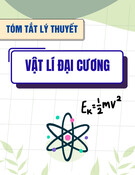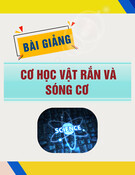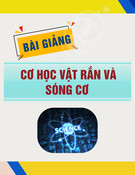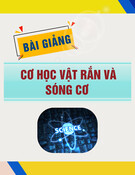
Nguyen Thi Phuong Thao, Tran Ngo / Tạp chí Khoa học và Công nghệ Đại học Duy Tân 6(49) (2021) 54-57
54
*Corresponding Author: Nguyen Thi Phuong Thao; Institute of Research and Development, Duy Tan University, Da
Nang, 550000, Vietnam; Department of Environment and Natural Science, Duy Tan University, Da Nang, 550000,
Vietnam
Email: thaonguyen@duytan.edu.vn
Shock waves emitted at the collapse of a laser-induced cavitation
bubble in the vicinity of a free surface
Sóng xung kích sinh ra tại thời điểm nổ bóng khí trong điều kiện có bề mặt thoáng gần kề
Nguyen Thi Phuong Thaoa,b*, Tran Ngoa,b
Nguyễn Thi Phương Thảoa,b*, Trần Ngọa,b
aInstitute of Research and Development, Duy Tan University, Da Nang, 550000, Vietnam
aViện Nghiên cứu và Phát triển Công nghệ Cao, Trường Đại học Duy Tân, Đà Nẵng, Việt Nam
bDepartment of Environment and Natural Science, Duy Tan University, Da Nang, 550000, Vietnam
bKhoa Môi trường và Khoa học Tự nhiên, Trường Đại học Duy Tân, Đà Nẵng, Việt Nam
(Ngày nhận bài: 9/11/2021, ngày phản biện xong: 13/11/2021, ngày chấp nhận đăng: 7/12/2021)
Abstract
We investigated the dynamic of a cavitation bubble induced by laser ablation in liquid in the vicinity of a free surface.
The observation was conducted using high-speed laser stroboscopic videography in photoelasticity mode. We showed
the bubble contracted faster in the vertical direction and formed a flat bubble at the minimum contraction. At the
collapse, the bubble emitted multiple shock waves. The dynamics of the bubble during contract phase and the emission
of multi shock waves were discussed in details.
Keywords: Cavitation bubble; laser ablation in liquid; photoelasticity images; shock waves.
Tóm tắt
Chúng tôi phân tích động học của bóng khí sinh ra bởi quá trình phá hủy bằng tia laser trong môi trường chất lỏng trong
điều kiện có mặt thoáng gần kề. Quan sát được tiến hành sử dụng kĩ thuật quay phim quang đàn hồi tốc độ cao. Chúng
tôi chỉ ra rằng bóng khí co lại nhanh hơn theo phương đứng và tạo thành bóng khí phẳng tại kích thước cực tiểu. Khi nổ,
bóng khí phát ra đa sóng shock. Động học quá trình co lại của bóng khí và sự phát sinh đa sóng shock được thảo luận
chi tiết.
Từ khóa: Bóng khí; phá hủy bằng tia laser trong môi trường chất lỏng; hình ảnh quang đàn hồi, sóng shock.
1. Introduction
When focusing a laser beam on a surface
immersed in liquid, the induced plasma initiates
a cavitation bubble. In laser machining and
surface treatment, laser-induced cavitation
bubble is considered a harmful phenomenon
that limits the machining effectiveness.
Moreover, the shock waves emitted at bubble
collapse can cause serious damages to the
machined surface. Thus, the dynamics of laser-
induced cavitation bubbles have received
intensive attention in the past decades.
6(49) (2021) 54-57

Nguyen Thi Phuong Thao, Tran Ngo / Tạp chí Khoa học và Công nghệ Đại học Duy Tân 6(49) (2021) 54-57
55
In infinite liquid, the dynamics of a bubble
has been well studied and has been shown to
follow the Rayleigh-Plesset model [1].
However, a spherical cavitation bubble
developed near a free boundary results in an
asymmetric collapse by that the bubble
collapses faster in one direction [1-3]. In the
studies on cavitation bubble induced in laser
ablation in liquid (LAL), the liquid depth is
usually considered infinite. However, LAL is
usually conducted under a thin liquid layer in
industry. For this reason, investigating the
shock emitted at the collapse of a laser-induced
cavitation bubble in the vicinity of a free
surface is of great importance.
In laser forward transfer of liquids (LFT),
the effects of a free surface on the dynamics of
a cavitation bubble has been investigated [4,5].
The interaction of bubble and free surface were
also considered in the studies on a single
spherical bubble [1,2]. In LAL, the cavitation
bubble induced is restrained in one direction.
Thus, the results for a spherical bubble can not
be directly applied. In LFT, the bubble is
restrained in one direction like in LAL.
However, they uses much smaller energy in
LFT in comparison to LAL. Furthermore, the
liquid layer is kept much thinner and the
emission of secondary shock is not considered
in the researches on LFT.
In this research, we aim to observe the
collapse and rebound of a cavitation bubble
induced by LAL in the vicinity of a free
surface. The emission of the shock wave at
bubble collapse is observed by high-speed laser
stroboscopic videography in photoelasticity
mode. The dynamical aspect of the bubble and
shock wave are discussed in detail. This
knowledge is useful for an optimal parameter
choice for applications of under-liquid laser
ablation.
2. Material and methods
The cavitation bubble was induced by
focusing a 1064 nm laser pulse, with full width
at half maximum (FWHM) = 13 ns on a solid
target. The target is an epoxy-resin block 20 x
5.8 x 28 mm3. The ablations were carried out in
pure water with the liquid-air interface at 3 mm
above the target surface. The pulse energy was
20 mJ. Photoelasticity images were obtained by
using high-speed laser stroboscopic
videography in photoelasticity mode. Details of
the technique and imaging system can be found
in our previous work [6].
3. Results and discussion
Figure 1 presents a time-resolved
observation of a laser-induced cavitation bubble
from the maximum radius until dozens of
microseconds after the collapse. The bubble
reached its maximum radius at 144 µs. At this
time, the bubble has a radius of about 2.8 mm,
which is approximate to the depth of the liquid
layer. After reaching the maximum radius, the
bubble begins to contract. The bubble appeared
to contract slower in the horizontal direction
compared to the vertical direction, forming a
flat bubble. The bubble reaches its minimum
radius at around 328 µs. At this time, the
bubble has the shape of a dish with the diameter
much larger than the height. At 336 µs we can
observe the emission of the shock waves,
represented themselves as many waves in the
water and the stress wave observed in the
target. After emitting the shock waves, the
bubble burst into a cluster of many smaller
bubbles, as can be seen in the frame taken at
384 µs.

Nguyen Thi Phuong Thao, Tran Ngo / Tạp chí Khoa học và Công nghệ Đại học Duy Tân 6(49) (2021) 54-57
56
Figure 1. Time resolved observation of laser-induced cavitation bubble in the contract phase. Liquid depth is 3 mm.
The pulse energy was 20 mJ. The first frame is demonstrated bubble at the maximum radius. The emitting of the shock
waves can be observed at 336 microseconds.
A detailed observation of shock wave
emitted at the collapse of the laser-induced
cavitation bubble near a free surface is
presented in Figure 2. Differ from the bubble in
infinite liquid which tends to emit a single
shock wave, the flattened bubble emitted
several shock waves. These shock waves look
non-concentric, i.e. like being originated from
the two sites of the bubble within some
hundreds of nanoseconds.
.
Figure 2. Detail observation of shock wave emitted at the
collapse of laser-induced cavitation bubble in the vicinity
of a free surface. The images was obtained at 336
microseconds after irradiation, pulse energy was 20 mJ.
The liquid layer thickness was 3 mm. .
To explain the multi emission of shock
waves, we need to consider the effect of a free
surface on the collapse of the bubble. If the
liquid is infinite, the expansion and collapse of
a bubble can be described by the Rayleigh-
Plesset model. However, in the vicinity of a
free surface, the bubble is restrained by a non-
symmetry environment: the liquid resistance in
the horizontal direction is larger than the
vertical direction (Fig. 3 (a)). This non-
symmetric makes the cavitation bubble
elongate in the vertical direction. Since the
difficulty in displacing the liquid layer is
reduced as the bubble approaches the free
surface, the bubble elongation is dominating. In
response to the expansion of the bubble, the
free surface is lifted and a liquid dome is
formed. This dome moves upward following
the expansion of the bubble as being shown in
Fig. 3 (b) and (c). When the bubble contracts,
between the free surface and the bubble forms a
high-pressure area. This high-pressure area
pushes the bubble and the air-liquid interface in
two opposite ways: the dome is pushed upward,
while the bubble surface is pushed downward
and a liquid jet is formed inside the bubble. In
this manner, the hemispherical bubble becomes
concave and finally develops into a toroidal
shape near its contraction. The compression of
a toroidal bubble leads to the collapse and
rebound happens at many discrete points along
the torus. As a result, the emission of multiple
shock waves can be expected [7].

Nguyen Thi Phuong Thao, Tran Ngo / Tạp chí Khoa học và Công nghệ Đại học Duy Tân 6(49) (2021) 54-57
57
Figure 3. Schematic of the expanse and collapse
of a cavitation bubble near a free boundary.
In our photoelasticity images, the bubble has
a dish shape near the contraction. This dish-
shaped bubble is the 2D projection of the
concave bubble mentioned above. Because the
shock waves were emitted from different
locations along the torus bubble, their
projection on a plane looks like many discrete
semicircles originating from two sites of the
bubble. If the liquid depth is increased, the non-
asymmetric of liquid environment causes less
effect on the bubble expansion. Thus, the
formation of the concave bubble is marginal.
The bubble will contract as a hemispherical and
emit a single near-circular shock wave, as being
reported in our previous [8].
4. Conclusion
We investigated the dynamic of laser-
induced cavitation bubble from the maximum
radius until several microseconds after collapse.
The observation showed that, in the vicinity of
a free surface, the bubble collapsed
asymmetrically and formed a flat bubble. At the
collapse, the bubble emitted multiple shock
waves rather than a single one. The observed
dynamics aspect of the bubble during contract
phase and the emission of multi shock waves
can be explained by considering the
asymmetric resistance of the liquid against the
bubble expansion.
Acknowledgment
The experiment results presented in this
paper were based on the experiments performed
at Department of Mechanical Engineering,
Nagaoka University of Technology, Japan. I
would like to express the great appreciation to
Prof. Yoshiro Ito and Dr. Rie Tanabe-
Yamagishi for their valuable support and
advice.
References
[1] P. Gregorčič, R. Petkovšek and J. Možina,
“Investigation of a cavitation bubble between a rigid
boundary and a free surface”, J. Appl. Phys. 102,
094904 (2007).
[2] P. B. Robinson, J. Blake, T. Kodama, A. Shima and
Y. Tomita, “Interaction of cavitation bubbles with a
free surface”, J. Appl. Phys. 89, 8225 (2001).
[3] B. Han, J. Chen, H. Zhang, Z. Shen, J. Lu and X. Ni,
“Influence of different interfaces on laser propulsion
in water environment”, Opt. Laser Technol. 42,
1049 (2010).
[4] M. Duocastella, J. M. Fernandez-pradas, J. L.
Morenza and P. Serra, “Time-resolved imaging of
the laser forward transfer of liquids”, J. Appl. Phys.
106, 084907 (2009).
[5] C. Unger, M. Gruene, L. Koch, J. Koch and B. N.
Chichkov, “Time-resolved imaging of hydrogel
printing via laser-induced forward transfer”, Appl.
Phys. A 103, 271 (2011).
[6] R. Tanabe, T. T. P. Nguyen, T. Sugiura, and Y. Ito,
“Bubble dynamics in metal nanoparticle formation
by laser ablation in liquid studied through high-
speed laser stroboscopic videography,” Appl. Surf.
Sci., 351, 327 (2015).
[7] C.-D. Ohl, T. Kurz, R. Geisler, O. Lindau and W.
Lauterborn, “Bubble dynamics, shock waves and
sonoluminescence”, Phil. Trans. R. Soc. Lond. A
357, 269 (1999).
[8] T. T. P. Nguyen, R. Tanabe, and Y. Ito, “Effects of
an absorptive coating on the dynamics of underwater
laser-induced shock process,” Appl. Phys. A, 116,
no. 3, pp. 1109–1117 (2013).












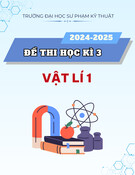
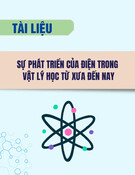
![Bộ câu hỏi lý thuyết Vật lý đại cương 2 [chuẩn nhất/mới nhất]](https://cdn.tailieu.vn/images/document/thumbnail/2025/20251003/kimphuong1001/135x160/74511759476041.jpg)
![Bài giảng Vật lý đại cương Chương 4 Học viện Kỹ thuật mật mã [Chuẩn SEO]](https://cdn.tailieu.vn/images/document/thumbnail/2025/20250925/kimphuong1001/135x160/46461758790667.jpg)




